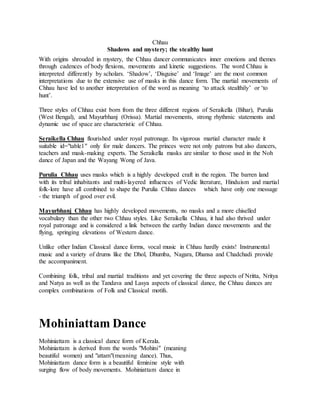
INDIAN Dancesforms part 2
- 1. Chhau Shadows and mystery; the stealthy hunt With origins shrouded in mystery, the Chhau dancer communicates inner emotions and themes through cadences of body flexions, movements and kinetic suggestions. The word Chhau is interpreted differently by scholars. ‘Shadow’, ‘Disguise’ and ‘Image’ are the most common interpretations due to the extensive use of masks in this dance form. The martial movements of Chhau have led to another interpretation of the word as meaning ‘to attack stealthily’ or ‘to hunt’. Three styles of Chhau exist born from the three different regions of Seraikella (Bihar), Purulia (West Bengal), and Mayurbhanj (Orissa). Martial movements, strong rhythmic statements and dynamic use of space are characteristic of Chhau. Seraikella Chhau flourished under royal patronage. Its vigorous martial character made it suitable id="table1" only for male dancers. The princes were not only patrons but also dancers, teachers and mask-making experts. The Seraikella masks are similar to those used in the Noh dance of Japan and the Wayang Wong of Java. Purulia Chhau uses masks which is a highly developed craft in the region. The barren land with its tribal inhabitants and multi-layered influences of Vedic literature, Hinduism and martial folk-lore have all combined to shape the Purulia Chhau dances which have only one message - the triumph of good over evil. Mayurbhanj Chhau has highly developed movements, no masks and a more chiselled vocabulary than the other two Chhau styles. Like Seraikella Chhau, it had also thrived under royal patronage and is considered a link between the earthy Indian dance movements and the flying, springing elevations of Western dance. Unlike other Indian Classical dance forms, vocal music in Chhau hardly exists! Instrumental music and a variety of drums like the Dhol, Dhumba, Nagara, Dhansa and Chadchadi provide the accompaniment. Combining folk, tribal and martial traditions and yet covering the three aspects of Nritta, Nritya and Natya as well as the Tandava and Lasya aspects of classical dance, the Chhau dances are complex combinations of Folk and Classical motifs. Mohiniattam Dance Mohiniattam is a classical dance form of Kerala. Mohiniattam is derived from the words "Mohini" (meaning beautiful women) and "attam"(meaning dance). Thus, Mohiniattam dance form is a beautiful feminine style with surging flow of body movements. Mohiniattam dance in
- 2. Kerala developed in the tradition of Devadasi system, which later grew and developed a classical status. Mohiniattam is a solo female dance (in a single costume), where musical melody and the rhythmical swaying of the dancer from side to side and the smooth and unbroken flow of the body movement is the striking feature. The Mohiniattam dance focuses mainly on feminine moods and emotions. Usually, the theme of Mohiniattam dance is "sringara" or love. Subtle subjects of love are executed with suggestive abhinaya, subtle gestures, rhythmic footwork and lilting music. The legend of Vishnu as "Mohini", (the enchantress) forms the core of Mohiniattam dance. The credit for reviving the Mohiniattam dance in the nineteenth century goes to Swati Tirunal. Swati Tirunal was an enlightened ruler of Travancore (Southern Kerala) and promoted the study of Mohiniattam. Swati Tirunal composed many of the musical arrangements and vocal accompaniments that provide musical background for the Mohiniattam dancers. The noted Malayalam poet Vallathol, who established the Kerala Kalamandalam dance school in 1930, also played an important role in reviving the Mohiniattam dance form. The performers of Mohiniattam dance usually wear an off-white colored sari with gold brocade borders. Hairs of the dancer are gathered in a bun and decorated with jasmine flowers. The Mohiniattam dancer is adorned with Gold Jewellery including necklaces, bangles, waistbands and anklets. The tinkling of the Jewellery produces music as the dancer performs the dance. Mohiniattam dance is accompanied by musical instruments like violin, Veena and Mridangam and the dancer narrates episodes from the epics and legends through elegant steps, rhythmic movements of her arms and amazing facial expressions. The Hastha Lakshandeepika is a classical text and forms the basis of hands and arms movement in Mohiniattam. Manipuri Dance Manipuri is one of the six major classical dances of India. Manipuri dance is indigenous to Manipur, the North eastern state of India. The Manipuri dance style is inextricably woven into the life pattern of Manipuri people. The most striking part of Manipur dance is its colorful decoration, lightness of dancing foot, delicacy of abhinaya (drama), lilting music and poetic charm. The Manipuri dance form is mostly ritualistic and draws heavily from the rich culture of the state of Manipur. Costumes used in the Manipur dance are colorful and the music carries a quaint charm. Manipuri dance is entirely religious and aims at gaining spiritual experience. The Manipuri dance is not only a medium of worship and delight but also essential for all socio-cultural ceremonies of Manipuri people. Looking from a religious and artistic point of view the Manipuri Classical dance is said to be one on the purest, modest, softest and mildest and
- 3. meaningful dances. Manipuri Dance is a common name and envelopes all the dance-forms of Manipur. Thus, Manipuri dance can be called a basket of various dances. According to legends the original creator of Manipuri dance was Radha and Krishna. This Rasa Leela dance is said to be repeated by Shiva and his consort, Goddess Uma in Lasya style (in Manipur). It is interesting to note that the same dance (Rasa-dance) was performed for the third time by two mortal human beings, princess Toibi and Khamba of Manipur. The dance performed by these two lovers is known as Lai Haraoba. The most important facet of Manipuri culture is that it has preserved the ancient ritual based dances and folk dances along with the later developed classical Manipuri dance style. Of all the classical categories, the 'Ras Leela' (a greatly evolved dance drama, choreographed on 'Vaishnavite Padavalis') is the utmost expression of artistic genius, devotion and excellence of the Manipuri people.